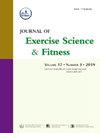One decade of school environment monitoring and its influence on providing adequate opportunities for engaging in physical activity from the Active Healthy Kids Global Alliance Global Matrices 1.0 to 4.0
IF 2.4
2区 医学
Q2 SPORT SCIENCES
引用次数: 0
Abstract
Background
The Global Matrix is an international initiative that monitors 10 indicators of health-related behaviours and sources of influence on child physical activity (PA) including within the school environment. This study examined global secular trends for the School indicator across Global Matrices 1.0 to 4.0, including its underlying benchmark evidence and socioeconomic indicators across the diverse global regions of participating jurisdictions.
Methods
School indicator and benchmarking data for each country were compiled for every Global Matrix edition from peer-reviewed and online resources. Benchmark scoring distributions, secular trends and socioeconomic indicators were synthesised to determine the variety and utility of each benchmark by region for report cards published from 2014 to 2024. Bivariate correlations were conducted within-edition between socioeconomic data and School indicator final scores.
Results
To date, >68 countries/jurisdictions have participated in at least one Global Matrix. Disparity in School indicator grades were apparent (range: A to F), irrespective of regional gross domestic product. The most common benchmark cited was “percent of schools where the majority (≥80 %) are offered the mandated amount of physical education (PE)”. Final grades were significantly associated to a country's GINI score (a measure of income inequality distribution; τ values = 0.274 to 0.572, p values= <0.001 to 0.030).
Conclusion
The School indicator is widely used across regions, and despite differences in countries’ socioeconomic development, its grading has remained balanced through its consistent use of key benchmarks, especially those reflecting a required amount of PE, and access to facilities and equipment. Countries with greater income equality tended to be graded higher on the School indicator than those exhibiting less income equality.
从积极健康儿童全球联盟全球矩阵1.0到4.0的十年学校环境监测及其对提供充分参与体育活动机会的影响
全球矩阵是一项国际倡议,监测与健康有关的10项行为指标和影响儿童身体活动的来源,包括在学校环境中。本研究考察了全球矩阵1.0至4.0中学校指标的全球长期趋势,包括其基本基准证据和参与司法管辖区不同全球地区的社会经济指标。方法根据同行评议和在线资源,为每一期《全球矩阵》编制各国学校指标和基准数据。基准得分分布、长期趋势和社会经济指标被综合起来,以确定2014年至2024年发布的报告卡中每个地区基准的多样性和效用。在社会经济数据和学校指标最终得分之间进行了版本内的双变量相关性。结果迄今为止,已有68个国家/司法管辖区参与了至少一个全球矩阵。无论地区国内生产总值(gdp)如何,学校指标评分的差异都很明显(范围:A至F)。最常见的基准是“大多数学校(≥80%)提供规定数量的体育教育(PE)的百分比”。最终成绩与一个国家的GINI分数(衡量收入不平等分配的指标;τ值= 0.274至0.572,p值= <;0.001至0.030)显著相关。学校指标在各地区广泛使用,尽管各国的社会经济发展存在差异,但通过一致使用关键基准,特别是反映所需体育锻炼数量和设施和设备使用情况的基准,其评分保持平衡。收入更平等的国家往往比收入不平等的国家在学校指标上得分更高。
本文章由计算机程序翻译,如有差异,请以英文原文为准。
求助全文
约1分钟内获得全文
求助全文
来源期刊
CiteScore
5.10
自引率
3.60%
发文量
54
审稿时长
31 days
期刊介绍:
The Journal of Exercise Science and Fitness is the official peer-reviewed journal of The Society of Chinese Scholars on Exercise Physiology and Fitness (SCSEPF), the Physical Fitness Association of Hong Kong, China (HKPFA), and the Hong Kong Association of Sports Medicine and Sports Science (HKASMSS). It is published twice a year, in June and December, by Elsevier.
The Journal accepts original investigations, comprehensive reviews, case studies and short communications on current topics in exercise science, physical fitness and physical education.

 求助内容:
求助内容: 应助结果提醒方式:
应助结果提醒方式:


